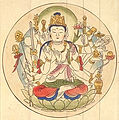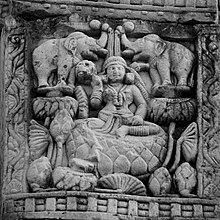This is an old revision of this page, as edited by Citation bot (talk | contribs) at 18:47, 18 December 2019 (Alter: template type. | You can use this bot yourself. Report bugs here.| Activated by User:Evrik | via #UCB_webform). The present address (URL) is a permanent link to this revision, which may differ significantly from the current revision.
Revision as of 18:47, 18 December 2019 by Citation bot (talk | contribs) (Alter: template type. | You can use this bot yourself. Report bugs here.| Activated by User:Evrik | via #UCB_webform)(diff) ← Previous revision | Latest revision (diff) | Newer revision → (diff)
In Asian art a lotus throne, sometimes lotus platform, is a stylized lotus flower used as the seat or base for a figure. It is the normal pedestal for divine figures in Buddhist art and Hindu art, and often seen in Jain art. Originating in Indian art, it followed Indian religions to East Asia in particular.
The precise form varies, but is intended to represent the opening flower of Nelumbo nucifera, the Indian lotus; in some Buddhist legends the baby Buddha emerged from a lotus flower. The Indian lotus is an aquatic plant similar to a water lily, though not actually any close relation. Among other unusual characteristics, nelumbo nucifera has particular properties of repelling water, known as the lotus effect or ultrahydrophobicity. Among other symbolic meanings, it rises above the water environment it lives in, and is not contaminated by it, so providing a model for Buddhists. According to the Pali Canon, the Buddha himself began this often-repeated metaphor, in the Aṅguttara Nikāya, saying that the lotus flower raises from the muddy water unstained, as he raises from this world, free from the defilements taught in the sutra.
In Sanscrit the throne is called either a padmasana (asana is the name for a seated position), which is also the name for the Lotus position in meditation and yoga, or padmapitha, padma meaning lotus and pitha a base or plinth.
History
The earliest of the Vedas, the Rigveda, describes the other gods watching the birth of Agni, the god of fire, seated on lotus flowers; also the birth of Vasishtha. In Hindu myth, the major deity Brahma emerged from a lotus growing from the navel of Vishnu.

In art the form is first seen as a base for rare early images of Laxmi from the 2nd century BCE; many or most of these may have a Buddhist context. However it first becomes common with seated Buddha figures in the Greco-Buddhist art of Gandhara around the late 2nd or the 3rd century CE. It may have reached the Deccan as early as the end of the 2nd century. At some point, probably around 200, and before his death in about 250, the Buddhist thinker Nagarjuna exhorted an unknown Buddhist monarch, very probably in the Deccan, to:
... Please construct from all precious substances
Images of Buddha with fine proportions
Well designed and sitting on lotuses ...
- suggesting this iconography was current by then. It is not clear from the language whether sculptures or paintings, or both, were meant.
In early Buddhist art it may be intended to specifically depict the second of the Twin Miracles in the legend of the Buddha's life. In some accounts of this, when engaged in a contest with sorcerers, the Buddha multiplied himself into other bodies, which sat or stood on lotus flowers. It became used for other Buddhist figures, and adopted for other Hindu deities than Laxmi.
Form
The throne in art evolved to be rather distant from the actual plant. In historic sculpture there is very often a clear dividing line about halfway up; this type is called a "double-lotus" (vishvapadma) pedestal or throne. Most often petal shapes both rise and fall from the dividing line, but sometimes the upper part of the throne represents the prominent flat-topped seed head as a base for the figure, perhaps with circles for the holes holding the seeds, as in maturing lotus heads. The bingdi lotus is a particular strain with two back-to-back flowers on each stem, but it is not clear if this influenced the form in art. In East Asian paintings, and also modern Hindu paintings, the lotus throne is often depicted more realistically in terms of its shape (though obviously not its size).
-
 Gaja-Laxmi, 1st century BCE, terracotta, 14.61 cm tall.
Gaja-Laxmi, 1st century BCE, terracotta, 14.61 cm tall.
-
 Gold dinar coin of Chandragupta II, reigned c. 375–c. 415 CE
Gold dinar coin of Chandragupta II, reigned c. 375–c. 415 CE
-
 Restrained double-lotus throne typical of Chola bronzes, when they have them at all. Shiva Nataraja, 10th century.
Restrained double-lotus throne typical of Chola bronzes, when they have them at all. Shiva Nataraja, 10th century.
-
 Double-thrones under Parvati, 11th century
Double-thrones under Parvati, 11th century
-
 Guanyin, 12th-century Japan
Guanyin, 12th-century Japan
-
Apart from the three figures, the pendent foot of this 12th-century Tibetan Mahakala has its own throne
-
 Krishna, the butter thief, ivory, 16th-century India
Krishna, the butter thief, ivory, 16th-century India
-
 Fancy coloured Buddhist throne under Mahakala, Ladakh
Fancy coloured Buddhist throne under Mahakala, Ladakh
-
 Single lotus throne under Gaja-Laxmi, with side stalks and buds, Odisha, 18th century
Single lotus throne under Gaja-Laxmi, with side stalks and buds, Odisha, 18th century
-
 Raja Ravi Varma, Goddess Lakshmi, 1896
Raja Ravi Varma, Goddess Lakshmi, 1896
Representing the whole plant

The vast majority of lotus thrones just depict an isolated flower, or a group of flowers under different figures. But some images depict more of the plant. A famous relief of Gaja-Laxmi in Cave 16 at Ellora shows a pond of lotus leaves and budding flowers as a vertical panel below the throne.
Other compositions show stalks, buds and flowers reaching up beside a main figure. These may terminate in a flower held by the main figure, especially if it is Avalokitesvara or from the 5th or 6th century Vishnu, (both also having the epithet Padmapani, "lotus holder"), or in another lotus throne behind the hand, if it is outstretched in a mudra. Alternatively, stalks may climb up to support lotus thrones underneath minor, smaller, figures, as in the early terracotta plaque illustrated above, where stalks rise at the side to support the elephants lustrating Gaja-Laxmi. This is seen in the 1st century BCE terracotta plaque illustrated above. The Sanchi stone relief illustrated here shows a similar composition with Queen Maya, mother of the Buddha. Above or below the water, the stems may be supported by small naga figures.
The lotus plant in lotus thrones is often imagined as growing out of the cosmic ocean, and a few images represent the plant below the water level, with a stem also representing the world axis.
Notes
- ^ Pal 1986, p. 39.
- ^ Pal 1986, p. 39-42.
- ^ Coomaraswamy 1935, p. 21.
- Krishan & Tadikonda, 65; Rodrigues
- the texts are: AN 10.81, "Bāhuna suttaṃ"; AN 4.36, "Doṇa suttaṃ".
- Jansen, 18
- Pal 1986, p. 45.
- Coomaraswamy 1935, p. 18-19.
- ^ Pal 1986, p. 40.
- Coomaraswamy 1935, p. 22.
- Krishan & Tadikonda, 78, note 89
- Moore & Klein, 149; Krishan & Tadikonda, 65
- Walser, 80-87
- Walser, 80, 86-87 for the date
- Walser, 81-83
- Krishan & Tadikonda, 67
- Lerner & Kossak, Nos. 68, 84, 88, 89, 92, 94, 97, 101 (for vishvapadma), 110, 111, 113 etc.
- Lerner & Kossak, Nos. 133, 139, 140; Hāṇḍā, Omacanda, Gaddi Land in Chamba: Its History, Art & Culture : New Light on the Early Wooden Temples, 78-79, 2005, Indus Publishing, ISBN 8173871744, 9788173871740, google books
- Michell, 362
- Lerner & Kossak, Nos. 116, 117, 119
- Coomaraswamy 1935, p. 53.
- Coomaraswamy 1935, p. 20, 53-55.
References
- Coomaraswamy, Ananda (1935). Elements of Buddhist Iconography. Harvard University Press.
- Jansen, Eva Rudy (1993). The Book of Hindu Imagery: The Gods and their Symbols. Binkey Kok Publications. ISBN 9789074597074.
- Krishan, Yuvrajmm; Tadikonda, Kalpana K. (1996). The Buddha Image: Its Origin and Development. Bharatiya Vidya Bhavan. ISBN 9788121505659.
- Lerner, Martin; Kossak, Steven (1991). The Lotus Transcendent: Indian and Southeast Asian Art from the Samuel Eilenberg Collection. New York, N.Y.: Metropolitan Museum of Art. ISBN 9780870996139.
- Michell, George (1990). The Penguin Guide to the Monuments of India. Vol. 1: Buddhist, Jain, Hindu. Penguin Books. ISBN 0140081445.
- Moore, Albert C.; Klein, Charlotte (1977). Iconography of Religions: An Introduction. Chris Robertson. ISBN 9780800604882.
- Pal, Pratapaditya (1986). Indian Sculpture: Circa 500 B.C.-A.D. 700. Vol. 1. Los Angeles County Museum of Art Collection. ISBN 9780520059917.
{{cite book}}:|work=ignored (help) - Rodrigues, H (2016). The Sacred Lotus Symbol. Mahavidya.
- Walser, Joseph (2005). Nagarjuna in Context: Mahayana Buddhism and Early Indian Culture. Columbia University Press. ISBN 9780231506236.
External links
 Media related to Lotus throne at Wikimedia Commons
Media related to Lotus throne at Wikimedia Commons